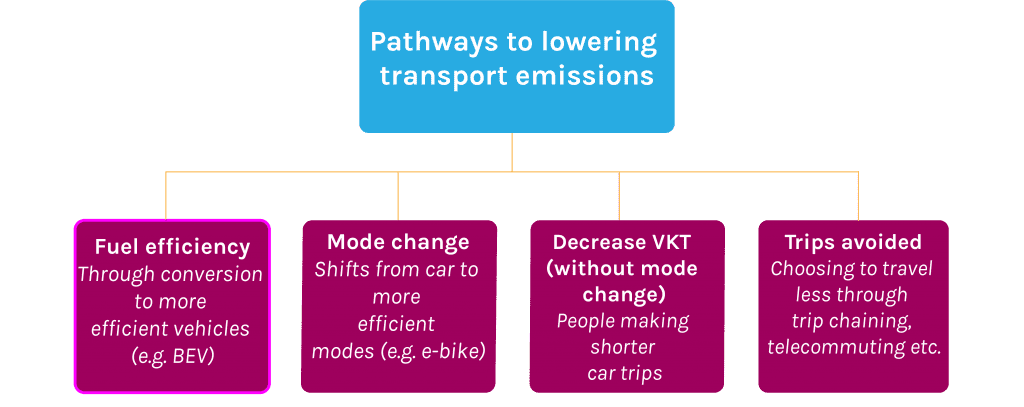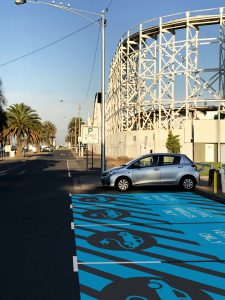In partnership with SGS Economics and Planning, we led this project for the City of Port Phillip, to prepare their transition to a zero-emission fleet by 2028. This project involved a detailed analysis of best practice electric vehicle charge examples, from both Australia and overseas, and an audit of the Council’s existing fleet. The figure below highlights the pathways through which transport emissions can be lowered. Electric vehicles can support moves for a more fuel-efficient fleet, as shown below. Transport emissions in Australia are currently increasing, and it is likely all of the four pathways will be needed for Australia to bring down its transport emissions.

Why are Electric Vehicles an important policy area?
Electric vehicle technology has advanced rapidly in recent years. Electric vehicles (EVs) avoid the tailpipe emissions of Internal Combustion Engine (ICE) vehicles, have lower running and servicing costs, and last longer. Compared to just five years ago, EVs:
- Have become cheaper
- Offer longer battery range, and
- Are available in a wider variety of vehicle types.
EVs also now have access to more chargers, including publicly available fast chargers, in more parts of Australia and this is set to grow further in coming years.
The presence of EVs in Australia is growing rapidly, albeit from a very low base, and the next two years are set to see the introduction of a number of lower-cost models that, while still more expensive to purchase than their ICE equivalents, will begin to compete strongly in terms of whole of life costs.
There are a number of different categories of EVs, and it is important to identify the main types, as shown below.
Different types of electric vehiclesThe following provides a brief description of each of the vehicle categories listed in the above figure.
- Conventional vehicle – also referred to as an Internal Combustion Engine (ICE) vehicle, is the standard vehicle type widely known and used since the invention of the motor vehicle. It is not an electric vehicle.
- Hybrid vehicle – a vehicle that uses petrol/diesel as its only fuel source, but also has an electric motor and battery that can store energy from regenerative braking. A Toyota Prius is a common example of a hybrid vehicle.
- Plug-in Hybrid Electric Vehicles (PHEV) – combines a mixture of fuel combustion and electricity. It is similar to the hybrid vehicle described above, however it has the ability to take electricity from a socket, and can store this in a battery. A Mitsubishi Outlander is an example of a model available as a PHEV.
Battery Electric Vehicles (BEV), or All-Electric, take electricity from a socket and relies entirely on the electricity stored in an on-board battery for propulsion. A Tesla S and Nissan Leaf are two popular models of BEV.
Electric vehicle chargers
The three main EV charging equipment characteristics that differentiate chargers from one another include (International Energy Agency, 2018) are identified below:
- Level: the power output range of the EVSE outlet. The maximum is lower for Alternative Current (AC) for most cars.
- Type: the socket and connector used for charging.
- Mode: the communication protocol between the vehicle and the charger.
The number of chargers and the speed with which a battery can be changed has improved significantly over recent years, and countries (including Australia) are building networks of fast chargers to facilitate long-distance travel. Table 1 provides a snapshot of different charging types.
One of the key global developments in charging over the last couple years has been advances in fast charging. Networks are currently being implemented to enable long-distance EV travel in Australia with chargers capable of delivering 200+kW DC to vehicles. Vehicle manufacturers are continuing to upgrade the ability of their cars to accept these high capacity chargers. In essence, what this means from a usability perspective is that an EV can be fully charged in as little as 15 minutes. It is important to recognise that this will be rare (few vehicles will be able to) and expensive (it is based on a battery optimised for high speed charging with other downsides). The reality is that most fast charging sessions, even now, are only 15-20 minutes – enough to get you to where you are going.
Our analysis of best practice EV charging found that there is a number is distinct charging markets that need to be considered when deciding on the right charging speed. This is captured in the illustration below.

Importantly, a significant proportion of the residential population lives in housing stock without access to off-street parking. This presents additional challenges for the charging of electric vehicles and this project included an analysis of how to plan for the installation of publicly accessible charging infrastructure. The image below offers an example of the design work prepare for the City of Port Phillip to demonstrate how EV charging bays may be incorporated into public spaces in the future.

We also developed a proposed publicly available charging network, including a policy to allow residents without off street parking to charge their vehicles.
If you’d like to work with us on electric vehicles, get in touch at info@sensibletransport.org.au
